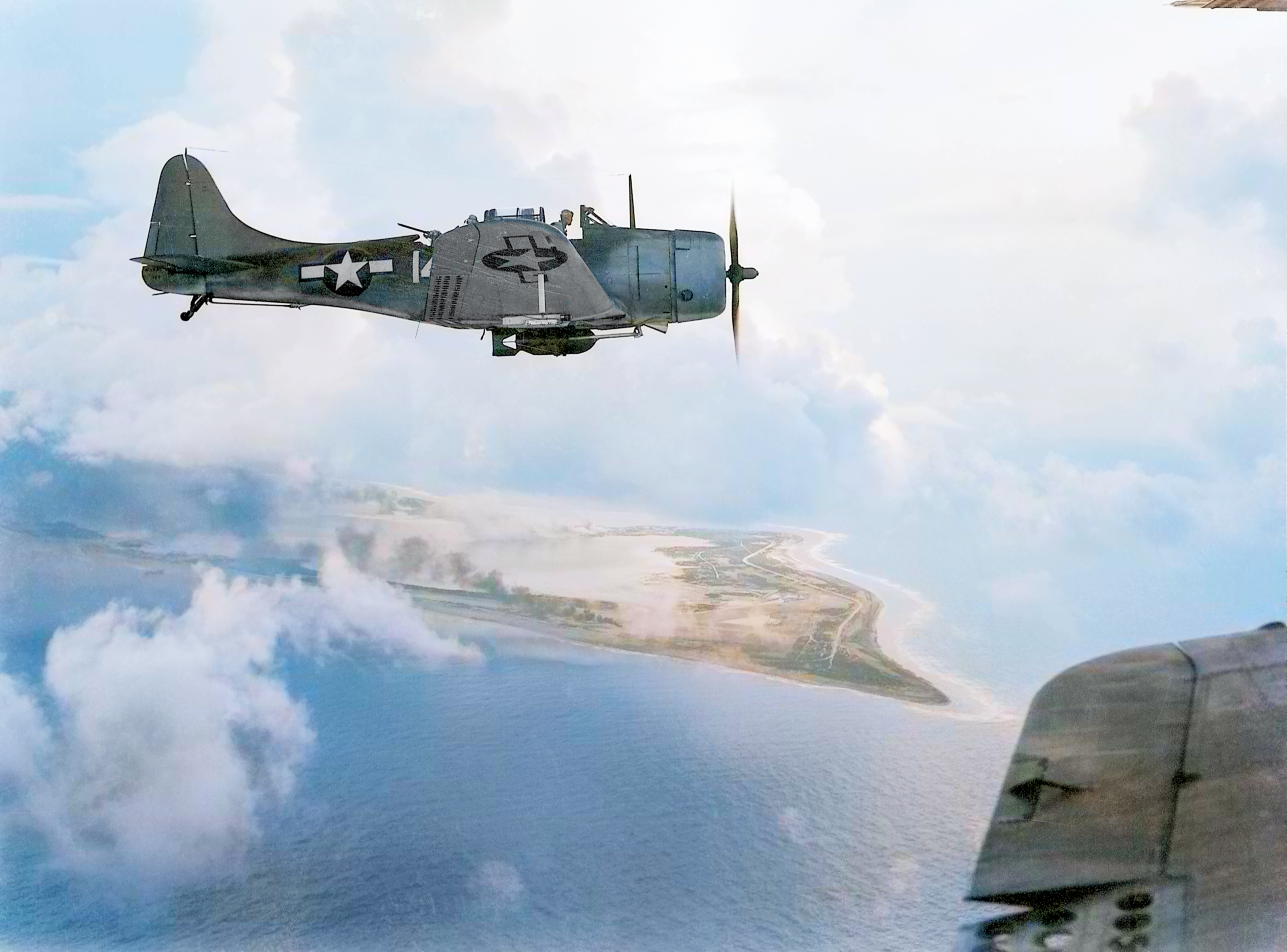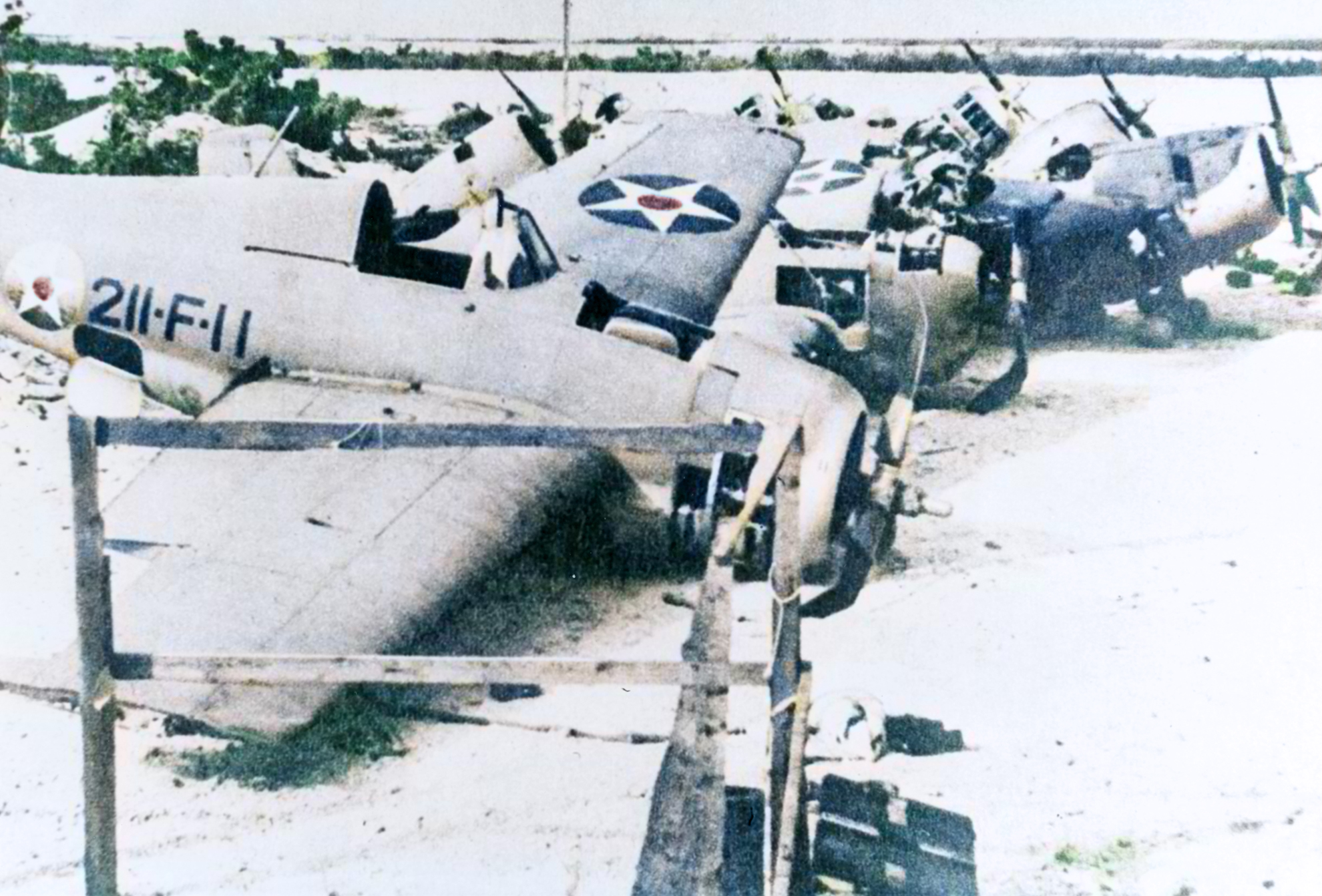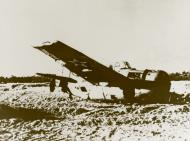Photographic Information
U.S. Marine Corps Marine Fighter Squadron VF-211 colorized slideshow



Grumman F4F-3 Wildcat VMF-211 Black 211F11 Wake Island Dec 1941 80-G-179006
Grumman F4F-3 Wildcat VMF-211 Black 211F11 Wake Island Dec 1941 80-G-179006
Description: Loss of Wake Island, December 1941 Wrecked Grumman F4F-3 Wildcat fighters of Marine Fighting Squadron 211 (VMF-211), photographed by by the Wake airstrip sometime after the Japanese captured the island on 23 December 1941. There appear to be at least seven F4Fs in this group. The plane in the foreground, 211-F-11 was flown by Captain Henry T. Elrod during the 11 December attacks that sank the Japanese destroyer Kisaragi. Damaged beyond repair at that time, 211-F-11 was subsequently used as a source of parts to keep other planes operational. Official U.S. Navy Photograph, now in the collections of the National Archives. Catalog #: 80-G-179006
Source: https://www.history.navy.mil/content/history/nhhc/our-collections/photography/numerical-list-of-images/nara-series/80-g/80-G-100000/80-G-179006.html
Wake Island
by: Samuel J. Cox, Director NHHC 29 Dec 2016
On the morning of 8 December (7 December, Pearl Harbor time) 36 Japanese twin-engine bombers from Kwajalein struck the U.S. outpost at Wake Island, a small atoll that served as a refueling stop for Pan-Am Clipper flying boats between Hawaii and Guam. Although Wake was alerted to the state of war with Japan, with no radar on the island, a pounding surf that drowned out the noise of planes, and favorable cloud conditions, the Japanese avoided detection by the four airborne Marine Wildcat fighter combat air patrol, and achieved surprise, destroying the remaining eight Wildcat’s on the runway (the 12 Wildcats of VMF-211 had only arrived from USS Enterprise (CV-6) on 4 Dec and no revetments had been completed yet) and killing almost half of the Marine aviation personnel (23 of 50) and wounding more. The bombers strafed the Pan Am Clipper that had just returned to Wake after aborting its flight to Guam upon word of war, but it was able to take on all Pan Am employees (except for native Chamorro workers who were left behind) and return to Hawaii. The bombers returned twice more in the next two days, bombing decoy gun positions (the Marines had moved the guns in anticipation that the Japanese would strike them next and made log decoys) and fighters shot down two bombers, however a lucky hit on dynamite storage of the civilian construction company upgrading the airfield and dredging the lagoon, caused massive secondary explosions that destroyed large quantities of ammunition.
The first Japanese amphibious assault occurred at dawn on 11 December as a Japanese force of older light cruisers and destroyers opened fire in an ineffective shore bombardment. Marine shore batteries (5” and 3” guns) held fire under orders of Senior officer Commander Winfield Cunningham and Marine detachment commander Major James P.S. Devereaux (both later claimed credit), until the Japanese ships were well in range. The Marine guns hit Rear Admiral Kajioka’s flagship, the light cruiser IJN Yubari, on the second salvo, eventually scoring eleven hits with serious damage. Marine gunners hit the destroyer IJN Hayate in the magazine which exploded with the loss of all hands but one (168) the first Japanese surface combatant sunk by the U.S. in the war (planes from USS Enterprise had sunk the Japanese submarine I-70 off Oahu on 10 Dec.) Other ships were hit and damaged, and the Japanese aborted the landing before any troops went ashore. Marine Wildcats strafed and bombed the retreating Japanese, damaging more ships and hitting the depth charge racks on the destroyer IJN Kisaragi, which exploded and sank with the loss of all hands (157). In subsequent days, Marine fighters and anti-aircraft accounted for 28 Japanese aircraft downed or damaged, but by the second Japanese assault on 23 Jan, despite extensive cannibalization, all Marine fighters had been lost or we no longer flyable. Following the first attack it was widely reported that the Wake Island senior officer, Commander Winfield Cunningham, sent a message to Hawaii requesting “send more Japs.” This is not true; the phrase originated in cryptographic “padding” – non-sensical phrases inserted into coded messages to complicate enemy code-breaking efforts (the same was true of the famous “the world wonders” phrase in Nimitz’ message to Halsey during the Battle of Leyte Gulf inquiring into the whereabouts of TF-34). The situation on Wake was desperate and both Cunningham and Deveraux knew it.
In response to the unexpected defeat, the Japanese detached two carriers (Hiryu and Soryu, with 108 aircraft) from the returning Pearl Harbor strike force, which commenced strikes on Wake on 21 Dec, and it was Zeros from the carriers that destroyed the last Marine fighters. The Japanese invasion force returned on 23 Dec, essentially the same force with replacements as the first attempt, still under the command of the much wiser RADM Kajioka. Japanese ships remained out of range of Marine shore batteries, and landed in positons not covered by the larger Marine guns under cover of darkness, and did not open fire until Japanese troops (bolstered by Special Naval Landing Force, i.e., Japanese “Marines”) had reached shore. Nevertheless in bitter combat throughout the pre-dawn hours into the morning, the 450 Marine defenders killed or wounded virtually the entire initial Japanese landing force (over 800 KIA, over 300 WIA) although the Japanese had several hundred more in reserve afloat. However, inability to communicate (largely due to previous Japanese bombing) with isolated pockets of still-resisting Marines convinced Commander Cunningham that Japanese success was much greater than it was, and that further resistance was futile. Cunningham gave the order to surrender and Deveraux complied, although it took several hours to get the Marines in contact to comply. In the end, 49 U.S. Marines, 3 Navy and 70 civilian workers were killed, and two Marines MIA, during the entire course of the “siege” of Wake Island. The Japanese captured 433 U.S. service members (20 died in captivity) and 1,104 civilian workers (108 died in captivity.)(Sources vary on some of these numbers.)
Of note, Marine pilot Captain Henry T. Elrod, who sank the destroyer Kisaragi and downed two Japanese aircraft, was posthumously awarded a Medal of Honor for his actions fighting as an infantryman during the second Japanese assault.
Source: https://www.history.navy.mil/about-us/leadership/director/directors-corner/h-grams/h-gram-002/h-002-2a.html
U.S. Marine Corps VMF-211 History
VMF-211 (1941-Present) - Wildcat Squadron
History: VMF-211 came to life on July 1, 1941, when the Marine Corps activated the squadron at Ewa Mooring Mast Field, Oahu, Hawaii, under Maj. Charles E. Wagner, a stern, barrel-chested aviator who molded a raw crew of 12 pilots into a tight unit flying Grumman F4F-3 Wildcats straight from the factory. Stationed at Ewa, a dusty outpost near Pearl Harbor, the squadron drilled in the humid Pacific air, their Wildcats—painted in glossy blue-gray—buzzing over cane fields as pilots like Capt. Henry T. Elrod, a wiry Georgian with a steady hand, prepped for war. On November 22, 1941, VMF-211’s 12 F4F-3s loaded aboard USS Enterprise at Pearl Harbor, bound for Wake Island under Maj. Paul A. Putnam, a lean, sharp-eyed leader; they landed December 4, just days before Japan struck. On December 8, 1941—hours after Pearl Harbor—Japanese bombers from Roi-Namur hit Wake, shredding eight Wildcats on the ground, but VMF-211 fought back, with Elrod downing two Mitsubishi G3M Nells that day, the first Marine air kills of the war. Over 11 days, Putnam’s dwindling band—down to four flyable F4F-3s by December 11—battled waves of attackers; Elrod sank the destroyer Kisaragi with a 100-pound bomb on December 11, a rare feat for a Wildcat, while 1st Lt. David D. Kliewer and 2nd Lt. John F. Kinney patched planes with scavenged parts. Wake fell on December 23, 1941, with survivors like Putnam captured—Elrod died fighting on the ground, earning a posthumous Medal of Honor. VMF-211 reformed in June 1942 at NAS Palmyra, Hawaii, under Maj. Luther S. Moore, taking on F4F-4 Wildcats and hitting Palau and Eniwetok in ’43 with F4U Corsairs under Lt. Col. Edward C. Dyer, racking up kills in the Central Pacific. The squadron ended WWII at Ulithi in ’45, deactivated briefly in 1946, then roared back in 1949 at MCAS Cherry Point, North Carolina, flying F9F Panthers in Korea under Lt. Col. Robert P. Keller, earning a Navy Unit Citation at Chosin Reservoir in 1950. Redesignated VMA-211 in 1952, it flew AD Skyraiders, then A-4 Skyhawks in Vietnam from Chu Lai in 1965 under Lt. Col. Charles E. Crew, logging 45,000+ sorties by 1990—Capt. Stephen W. Pless nabbed a Medal of Honor in ’67. Today, as VMA-211 “Wake Island Avengers” at MCAS Yuma, Arizona, under Col. David R. Steele, it flies F-35B Lightning IIs, a legacy born from those Wildcats at Wake.
Highlights:
Established: July 1, 1941, at Ewa, Oahu—early shots might show F4F-3s on dirt strips, pilots like Maj. Wagner in khakis by bamboo hangars.
Aircraft (Wildcat Era): F4F-3 Wildcats in ’41 (four guns, fixed wings, BuNo 2526-2537), F4F-4s by ’42 (six guns, folding wings)—look for Wake pics with “211” on fuselages, often battle-scarred.
Wake Island (1941): Arrived December 4, 1941—photos could show 12 Wildcats lined up pre-attack, or wreckage post-December 8 bombing; Elrod’s F4F might have bomb racks jury-rigged.
Aces: Capt. Henry T. “Hammerin’ Hank” Elrod scored 2 kills, sank Kisaragi—possible shots of him, stocky and squinting, by his Wildcat (BuNo 2532) before his ground death.
1st Lt. David D. Kliewer got 2-3 kills—look for a lean pilot near a patched F4F.
Kills: 10-12 Japanese aircraft at Wake (mostly G3M Nells, some Zeros), total 50+ in WWII with Corsairs—victory marks might show on Wildcat noses.
Reform and Corsairs: June ’42 at Palmyra, F4F-4s, then F4Us by ’43—pics might shift to bent-wing Corsairs, “211” still visible.
Later Wars: Korea (F9F Panthers, 1950), Vietnam (A-4 Skyhawks, 45,000+ sorties), now F-35Bs—modern jets contrast with Wake’s gritty Wildcats.
Current: VMA-211 “Wake Island Avengers” at MCAS Yuma—stealth fighters honor the 1941 stand.
Bibliography:
Magazine References: +
- Airfix Magazines (English) - http://www.airfix.com/
- Avions (French) - http://www.aerostories.org/~aerobiblio/rubrique10.html
- FlyPast (English) - http://www.flypast.com/
- Flugzeug Publikations GmbH (German) - http://vdmedien.com/flugzeug-publikations-gmbh-hersteller_verlag-vdm-heinz-nickel-33.html
- Flugzeug Classic (German) - http://www.flugzeugclassic.de/
- Klassiker (German) - http://shop.flugrevue.de/abo/klassiker-der-luftfahrt
- Le Fana de L'Aviation (French) - http://boutique.editions-lariviere.fr/site/abonnement-le-fana-de-l-aviation-626-4-6.html
- Le Fana de L'Aviation (French) - http://www.pdfmagazines.org/tags/Le+Fana+De+L+Aviation/
- Osprey (English) - http://www.ospreypublishing.com/
- Revi Magazines (Czech) - http://www.revi.cz/
Web References: +
- History of RAF Organisation: http://www.rafweb.org
- Wikipedia, the free encyclopedia: http://en.wikipedia.org/
 Editor for Asisbiz: Matthew Laird Acred
Editor for Asisbiz: Matthew Laird Acred
If you love our website please donate so we can make this site even better !!







